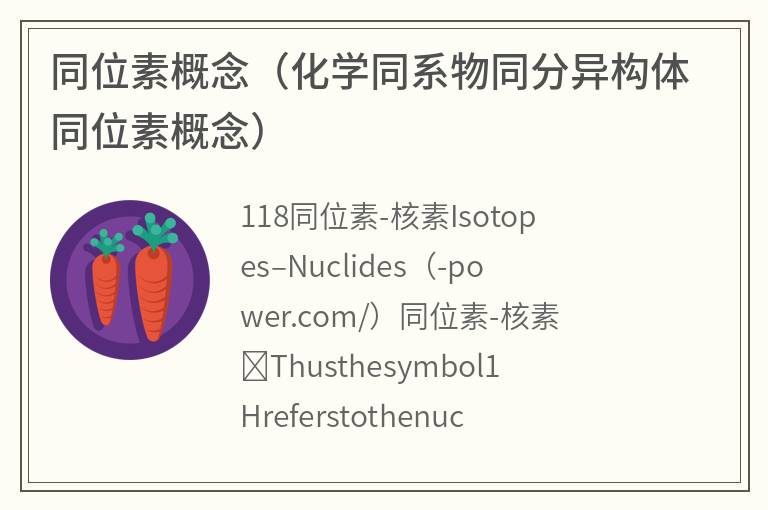118同位素-核素
Isotopes–Nuclides
(-power.com/)

同位素概念(化学同系物同分异构体同位素概念)
同位素-核素
?Thusthesymbol1Hreferstothenuclideofhydrogenwithasingleprotonasnucleus.2Histhehydrogennuclidewithaneutronaswellasaprotoninthenucleus(2Hisalsocalleddeuteriumorheavyhydrogen).Atomssuchas1H,2Hwhosenucleicontainthesamenumberofprotonsbutdifferentnumberofneutrons(differentA)areisotopes.Uranium,forinstance,hasthreeisotopesoccurringinnature–238U,235Uand234U.Allhave92protonsintheirnuclei.But,whereasthe235Uisotopehas143neutronsinitsnucleus,thatofthe238Uisotopecontains146neutrons.Thestableisotopes(plusafewoftheunstableisotopes)aretheatomsthatarefoundinthenaturallyoccurringelementsinnature.However,theyarenotfoundinequalamounts.Someisotopesofagivenelementaremoreabundantthanothers.Forexample99,27%ofnaturallyoccuringuraniumatomsaretheisotope238U,0,72%aretheisotope235Uand0,0055%aretheisotope234U.
因此符号1H指的是原子核为一个质子的氢核素。2H是原子核中有一个中子和一个质子的氢核素(也叫氘或重氢)。像1H、2H这样的原子,其原子核中含有相同数量的质子,但不同数量的中子(不同的A)是同位素。例如,铀在自然界中有三种同位素——238U、235U和234U。它们的原子核中都有92个质子。但是,235U同位素的原子核中有143个中子,而238U同位素的原子核中有146个中子。稳定同位素(加上一些不稳定同位素)是在自然界中天然存在的元素中发现的原子。然而,它们的数量并不相等。某一特定元素的某些同位素比另一些更富集。如99.27%的天然铀原子为238U,0.72%为235U,0.0055%为234U。
Becausealltheisotopesofagivenelementexhibitthesamechemicalproperties,theirseparationisverydifficultbychemicalmeans.Thetraditionalmethodsofisotopeseparationarebaseddirectlyontheatomicweightoftheisotopeorbasedonthesmalldifferencesinchemicalreactionratesproducedbydifferentatomicweights.Thesemethodshaveincludedmassspectometry,centrifugalseparationandprocessesthatdependonthedifferentratesatwhichheavyandlightparticlesdiffuse.
由于某一给定元素的所有同位素表现出相同的化学性质,用化学方法分离它们是非常困难的。传统的同位素分离方法直接基于同位素的原子重量,或基于不同原子重量产生的化学反应速率的微小差异。这些方法包括质谱、离心分离和取决于轻重粒子扩散速率的工艺。
注:
(以下内容来自百度百科)
同位素分离方法可分为四类:
(1)直接利用同位素质量差别,如电磁分离,离心分离;
(2)利用平衡分子传递性质的差别;如扩散、热扩散、离子迁移,分子蒸馏;
(3)利用热力学性质上的差别(化学平衡和相平衡),如精馏、化学交换、萃取、吸收、吸附、离子交换、结晶;
(4)利用同位素化学反应动力学性质上的差别,如电解、光化学分离(包括激光分离)。
(待续)


发表评论